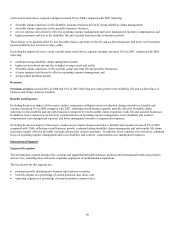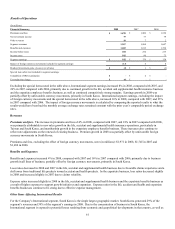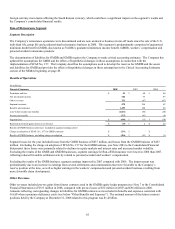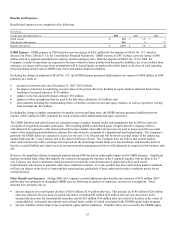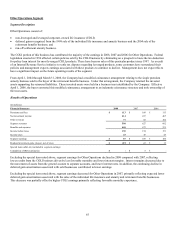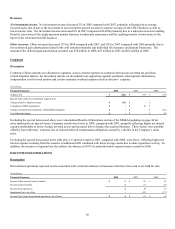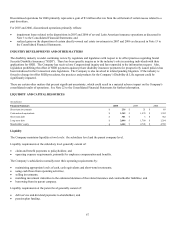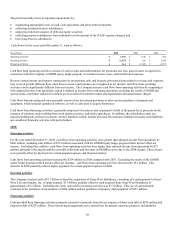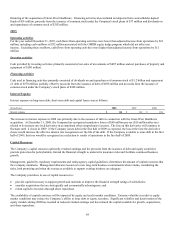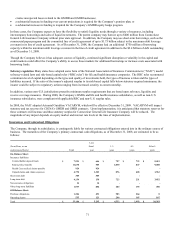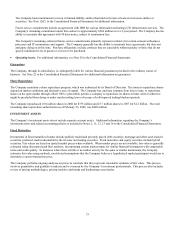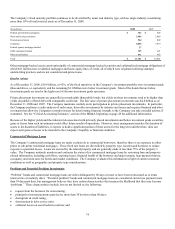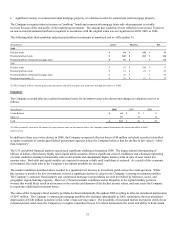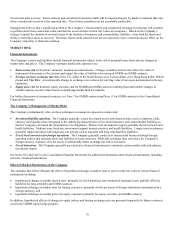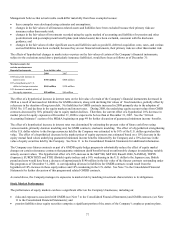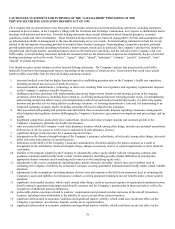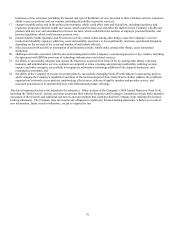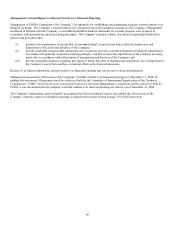Cigna 2008 Annual Report Download - page 90
Download and view the complete annual report
Please find page 90 of the 2008 Cigna annual report below. You can navigate through the pages in the report by either clicking on the pages listed below, or by using the keyword search tool below to find specific information within the annual report.
70
On March 14, 2008, the Company entered into a new commercial paper program (“the Program”). Under the Program, the Company
is authorized to sell from time to time short-term unsecured commercial paper notes up to a maximum of $500 million. The proceeds
are used for general corporate purposes, including working capital, capital expenditures, acquisitions and share repurchases. The
Company uses the credit facility described below as back-up liquidity to support the outstanding commercial paper. If at any time
funds are not available on favorable terms under the Program, the Company may use the Credit Agreement (see below) for funding. In
October 2008, the Company added an additional dealer to its Program. As of December 31, 2008, the Company had $299 million in
commercial paper outstanding, at a weighted average interest rate of 6.31%, used to finance the Great-West Healthcare acquisition and
for other corporate purposes.
On March 4, 2008, the Company issued $300 million of 6.35% Notes (with an effective interest rate of 6.68% per year). Interest is
payable on March 15 and September 15 of each year beginning September 15, 2008. The proceeds of this debt were used for general
corporate purposes, including financing the acquisition of Great-West Healthcare. These Notes will mature on March 15, 2018. The
Company may redeem these Notes, at any time, in whole or in part, at a redemption price equal to the greater of:
• 100% of the principal amount of the Notes to be redeemed; or
• the present value of the remaining principal and interest payments on the Notes being redeemed discounted at the applicable
Treasury Rate plus 40 basis points.
In June 2007, the Company amended and restated its five-year committed revolving credit and letter of credit agreement for $1.75
billion, which permits up to $1.25 billion to be used for letters of credit. This agreement is diversified among 22 banks, with three
banks each having 11% of the commitment and the other 21 banks having the remaining 67% of the commitment. The credit
agreement includes options, which are subject to consent by the administrative agent and the committing banks, to increase the
commitment amount up to $2.0 billion and to extend the term of the agreement. The Company entered into the agreement for general
corporate purposes, including support for the issuance of commercial paper and to obtain statutory reserve credit for certain
reinsurance arrangements. There was a $25 million letter of credit issued as of December 31, 2008.
Liquidity and Capital Resources Outlook
At December 31, 2008, there was approximately $90 million in cash available at the parent company level. In 2009, the parent
company’s debt service consists of scheduled interest payments of approximately $140 million on outstanding long term debt of $2.1
billion at December 31, 2008 and approximately $300 million of commercial paper that will mature over the next three months. There
are no scheduled long-term debt repayments in 2009. The company expects to refinance the commercial paper either by issuing long-
term debt or re-issuing commercial paper.
The Company’s best estimate is that contributions to the qualified pension plan will be approximately $410 million pre-tax during
2009. The parent company expects to fund the $410 million pre-tax contribution with subsidiary contributions equal to GAAP
expense and parent company tax benefits. However, this amount could change based on final valuation amounts and the level at
which the Company decides to fund the plan. The parent company would fund the estimated remaining $130 million net after-tax
contribution with ongoing parent company cash sources including, but not limited to, subsidiary dividends. These estimates do not
include funding requirements related to the litigation matter discussed in Note 22 to the Consolidated Financial Statements, as
management does not expect this matter to be resolved in 2009. Future years’ contributions will ultimately be based on a wide range
of factors including but not limited to asset returns, discount rates, and funding targets.
The availability of resources at the parent company level is partially dependent on dividends from the Company’s subsidiaries, most of
which are subject to regulatory restrictions and rating agency capital guidelines, and partially dependent on the availability of liquidity
from the issuance of debt or equity securities.
The Company expects, based on current projections for cash activity, to have sufficient liquidity to meet its obligations.
However, the Company’s cash projections may not be realized and the demand for funds could exceed available cash if:
• ongoing businesses experience unexpected shortfalls in earnings;
• regulatory restrictions or rating agency capital guidelines reduce the amount of dividends available to be distributed to the parent
company from the insurance and HMO subsidiaries (including the impact of equity market deterioration and volatility on
subsidiary capital);
• continued significant disruption or volatility in the capital and credit markets reduces the Company’s ability to raise capital or


